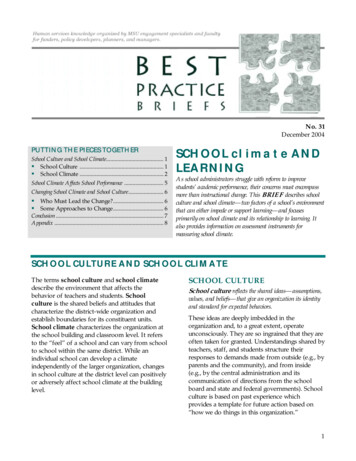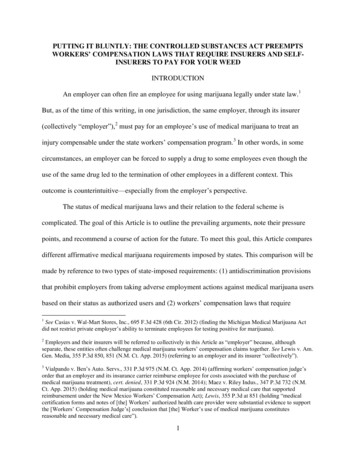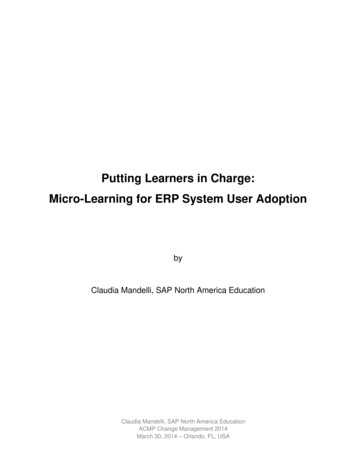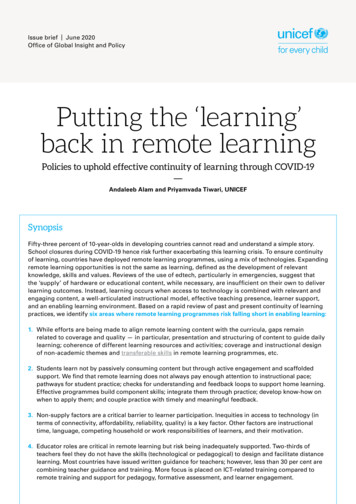
Transcription
No. 31December 2004PUTTING THE PIECES TOGETHERSchool Culture and School Climate. 1 School Culture . 1 School Climate . 2School Climate Affects School Performance . 5Changing School Climate and School Culture. 6 Who Must Lead the Change?. 6 Some Approaches to Change. 6Conclusion . 7Appendix . 8SCHOOL climate ANDLEARNINGAs school administrators struggle with reform to improvestudents’ academic performance, their concerns must encompassmore than instructional change. This BRIEF describes schoolculture and school climate—two factors of a school’s environmentthat can either impede or support learning—and focusesprimarily on school climate and its relationship to learning. Italso provides information on assessment instruments formeasuring school climate.SCHOOL CULTURE AND SCHOOL CLIMATEThe terms school culture and school climatedescribe the environment that affects thebehavior of teachers and students. Schoolculture is the shared beliefs and attitudes thatcharacterize the district-wide organization andestablish boundaries for its constituent units.School climate characterizes the organization atthe school building and classroom level. It refersto the “feel” of a school and can vary from schoolto school within the same district. While anindividual school can develop a climateindependently of the larger organization, changesin school culture at the district level can positivelyor adversely affect school climate at the buildinglevel.SCHOOL CULTURESchool culture reflects the shared ideas—assumptions,values, and beliefs—that give an organization its identityand standard for expected behaviors.These ideas are deeply imbedded in theorganization and, to a great extent, operateunconsciously. They are so ingrained that they areoften taken for granted. Understandings shared byteachers, staff, and students structure theirresponses to demands made from outside (e.g., byparents and the community), and from inside(e.g., by the central administration and itscommunication of directions from the schoolboard and state and federal governments). Schoolculture is based on past experience whichprovides a template for future action based on“how we do things in this organization.”1
Components of School CultureCulture is reflected in an organization’satmosphere, myths, and moral code. Thecharacteristics of a school district’s culture can bededuced from multiple layers: Artifacts and symbols: the way its buildingsare decorated and maintained Values: the manner in which administrators,principals and staff function and interact Assumptions: the beliefs that are taken forgranted about human natureAs a school district’s culture develops over time, itis maintained by several practices: Common beliefs and values that keyindividuals communicate and enforce Heroes and heroines whose actions andaccomplishments embody these values Rituals and ceremonies that reinforce thesevalues Stories that reflect what the organizationstands for1The following chart shows how thesecomponents of school culture can support orimpede learning.School culture that Supports LearningThe building and its arrangements reflect thechildren, their needs, and their educationalaccomplishments.ValuesAdministrators, teachers, students, and parentsparticipate in decision making.Assumptions All students can learn.and beliefsParents want their children to succeed.Parents are partners in education.Artifacts andsymbolsSCHOOL CLIMATESchool climate reflects the physical and psychologicalaspects of the school that are more susceptible to change andthat provide the preconditions necessary for teaching andlearning to take place.School climate, the focus of this BRIEF, isevident in the feelings and attitudes about aschool expressed by students, teachers, staff andparents—the way students and staff “feel” aboutbeing at school each day.1School climate is a significant element indiscussions about improving academicperformance and school reform. It is alsomentioned in discussions of potential solutions toproblems such as bullying, inter-student conflicts,suicide, character education, and moral education.2Impedes LearningThere is little that reflects an emphasison children and their education.Decisions are made without participationof teachers and parents.Some students are incapable of learningor too lazy to learn. Parents don’t care.Parents know nothing about education.Components of School ClimateAlthough there is no consistent agreement in theliterature on the components of school climate ortheir importance, most writers emphasize caringas a core element. However, some place safetyforemost,2 defining school climate as “an orderlyenvironment in which the school family feelsvalued and able to pursue the school’s missionfree from concerns about disruptions and safety.”Several aspects of a school’s physical and socialenvironment comprise its climate. Oneorganization identified the following eight areas: Appearance and physical plant Faculty relations Student interactions Leadership/decision making
Disciplined environment Learning environment Attitude and culture School-community relations3The comprehensive view used in this BRIEF,and summarized below, defines school climate interms of four aspects of the school environment: A physical environment that is welcomingand conducive to learning A social environment that promotescommunication and interaction An affective environment that promotes asense of belonging and self-esteem An academic environment that promoteslearning and self-fulfillment1Supports LearningA Physical that is Welcomingand Conducive toLearning Environment School building contains a limitednumber of students.Students are, and feel, safe andcomfortable everywhere on schoolproperty.Classrooms are orderly.Classrooms and grounds are cleanand well-maintained.Noise level is low.Areas for instruction and activitiesare appropriate for those uses.Classrooms are visible and inviting.Staff members have sufficienttextbooks and supplies.Impedes Learning Supports LearningA SocialEnvironment that PromotesCommunicationand Interaction Interaction is encouraged. Teachersand students actively communicate.Teachers are collegial. Studentgroupings are diverse. Parents andteachers are partners in theeducational process.Decisions are made on-site, with theparticipation of teachers.Staff are open to students’suggestions; students haveopportunities to participate indecision-making.Staff and students are trained toprevent and resolve conflicts.School building contains a largenumber of students.Students are harassed by otherstudents in halls, restrooms, lunchrooms, or playgrounds.Classrooms are disorganized.Classrooms and grounds are dirty,poorly lit, and poorly maintained.Noise level is high.Classrooms are in rooms notintended for that use. Space isovercrowded.Classrooms are hidden andprotected from scrutiny.Textbooks and supplies areinsufficient. Deliveries are delayed.Impedes Learning Interaction is limited. Students andteachers do not speak to each other.Teachers are isolated from oneanother. Students self-segregate.Parents are not treated as equalpartners.All decisions are made by centraladministration or the principalwithout teacher involvement.Students have no role in determiningclassroom or building activities anddecisions.Bullying and conflicts are ignored.3
Supports LearningAn Affective that Promotes aSense ofBelonging andSelf-Esteem Environment Interaction of teachers and staffwith all students is caring,responsive, supportive, andrespectful.Students trust teachers and staff.Morale is high among teachersand staff.Staff and students are friendly.The school is open to diversityand welcoming to all cultures.Teachers, staff, and students arerespected and valued.Teachers, staff and students feelthat they are contributing to thesuccess of the school.There is a sense of community.The school is respected andvalued by teachers, staff,students, and families.Parents perceive the school aswarm, inviting and helpful.Impedes Learning Supports LearningAn AcademicEnvironment that PromotesLearning andSelf-Fulfillment 4There is an emphasis onacademics, but all types ofintelligence and competence arerespected and supported.Teaching methods respect thedifferent ways children learn.Expectations are high for allstudents. All are encouraged tosucceed.Progress is monitored regularly.Results of assessments arepromptly communicated tostudents and parents.Results of assessments are usedto evaluate and redesign teachingprocedures and content.Achievements and performanceare rewarded and praised.Teachers are confident andknowledgeable.Interaction of teachers and staff withstudents is generally distant andminimal. Students are subject tofavoritism. Some students areoverlooked. The circumstances of somestudents are ignored.Students do not see teachers and staff asacting in their interest.Morale is low among teachers and staff.Staff and students are unfriendly.The school “belongs” to the majoritystudents.Teachers and staff feel unappreciated.Students receive no positivereinforcement for work or actions.Teachers, staff and students do not feelthey have any impact on what happensin the school.Teachers, staff, students, and families donot feel they are part of the schoolcommunity.Parents do not feel welcome at theschool. Parents feel “blamed” for theirchild’s difficulties.Impedes Learning Academic performance is downplayedor not rewarded. Teaching methods donot allow for a variety of learning styles.Expectations are low. Some students areexpected to fail.There is minimal or no periodicassessment.There is little communication aboutresults of assessments. Students do notknow how to improve theirperformance. Parents discover that theirchild is struggling academically at reportcard time.Results are not used to improveteaching and learning. Teachers andstudents repeat the same cycle of failure.Rewards and praise are minimal.Teachers are unsure or under-prepared.
Interrelationships. These various aspects ofschool climate do not operate independently ofone another. For example, the physicalenvironment can encourage or discourage socialinteraction. Similarly, social interaction facilitates awarm, affective environment. Collectively, thephysical, social and affective environmentscontribute to, and are impacted by, the academicenvironment.How does school climate affect schoolperformance?Numerous studies document that students inschools with a better school climate have higherachievement and better socioemotional health.Probably the most comprehensive work in thisarea is being done by the Search Institute, anonprofit organization that encourages schoolsand communities to develop and empower youngpeople.In a review of studies on the impact of support inschool, the Search Institute found that a caringschool climate is associated with: Higher grades, engagement, attendance,expectations and aspirations, a sense ofscholastic competence, fewer schoolsuspensions, and on-time progression throughgrades (19 studies)Search Institute AssetsThe Search Institute is a nonprofit researchorganization that researches and promotes thedevelopment of external and internal assets foryouth. Although the Institute’s exploration ofdevelopmental assets does not discuss schoolclimate per se, the external assets it has identifiedreflect the environment that results in thebehavior and values identified in the internalassets. The following external assets, excerptedfrom the Search Institute’s 40 DevelopmentalAssets , are descriptive of school climate:SupportOther adult relationships. Young person receivessupport from three or more non-parent adults. Higher self-esteem and self-concept(5 studies)Caring school climate. School provides a caring,encouraging environment. Less anxiety, depression and loneliness(3 studies)Empowerment 4Less substance abuse (4 studies)Another study, by John Schweitzer of MichiganState University, found that when students inDetroit schools felt a sense of community withone another and a sense of belonging to theirschools, they achieved higher scores on MEAPtests.5A national study of more than 12,000 seventh totwelfth graders found that connectedness tofamily and school significantly protects youthfrom seven of eight behaviors risky to theirhealth.6Community values youth. Young person perceives thatadults in the community value youth.Youth as resources. Young people are given useful rolesin the community.Safety. Young person feels safe at . school.Boundaries and ExpectationsSchool boundaries. School provides clear rules andconsequences.High expectations. Teachers encourage the young personto do well.4Measuring school climate. There are numerousinstruments designed to measure what variousauthors define as school climate. These are listedand rated in the Appendix.5
CHANGING SCHOOL CLIMATE And School CultureImproving student behavior and academicperformance generally requires changing schoolclimate and school culture. Change may requiremoving individuals and organizations along acontinuum from “at risk” to “safe” to “thriving.”This process takes time to accomplish.7SOME APPROACHES TO CHANGE Reward students for appropriate behaviorWhile making positive changes in school climatemotivates staff and students to improve, thedistrict-level school culture must also change ifschool reforms are to be sustained for long-termimprovement. Enforce consequences for inappropriatebehavior Use contracts with students to reinforcebehavioral expectations Post behavioral policies on bulletin boards;periodically announce them over the publicaddress system Initiate anti-bullying, conflict resolution andpeer mediation programs Engage students, staff and parents in planningschool safety activities Increase number and accessibility ofcounselors, social workers, and mentors Create anonymous tip lines or suggestionboxes for reporting potentially dangeroussituations or providing ideas to improveschool climateThe superintendent of the district and the centraladministration, backed by the school board,initiate and promote changes in school cultureand school climate. Their decisions on buildingsize, budget allocations, selection of staff, as wellas communication of the school district’s mission,training priorities, and promotional activities, allplay a part in encouraging change. Provide more in-school options to “blow offsteam” Develop strategies to ensure safety duringlunch periods and between classes; providemore structured activities during lunch hour Provide accommodation or time-out roomsthroughout the dayWithin each building, the principal plays a primaryrole, providing leadership, articulating goals andbehavioral expectations of teachers, and supporting staff in developing an effective school.1 Whenteachers are supported, students are supported. Provide in-school suspension programs withacademic supports and consistent staffingThe role of teachers. Site-based managementand the organization of principals, teachers, andstaff into a learning community8 are routes toparticipatory decision making. When teachers areactively involved in mapping change, the result isimproved morale and willing participation. Both school climate and school culture requiresignificant attention when a principal orsuperintendent is new or when major changes arebeing implemented in the school system. It isworth noting that educational reform under theNo School Left Behind Act is essentially a longterm effort to change school culture. Note thecentral mantras of educational reform: Teachers and the school are accountable. All children can and must learn.Promoting a Safe and Orderly Environment Maintain buildings in good physical conditionWHO MUST LEAD THE CHANGE?6Facilitating Interaction and Relationships Build smaller middle and high schoolsReduce the impact of size in larger schools9, 10by dividing large middle and high schools intosmaller self-contained units; organizingstudents into cohorts that move throughclasses as a group; and reducing the numberof teachers interacting with each student in
middle school by assigning home room or asecond subject to a subject area teacher Use smaller teacher-student ratios (no morethan 80 students per teacher in a secondaryschool) Use team teaching Provide for small group activities Provide multiple and varied opportunities toparticipate in extracurricular activitiesPromoting a Positive Affective Environment Use summer school rather than retention ingrade for failing students Promote cooperation rather than competition;avoid winners and losers Assure that every student has an activeconnection to at least one adult in the school Provide professional development on suchissues as cultural and class differences,emotional needs of other children, parentalinvolvement, and bullying and harassmentThe Size of the SchoolThe number of students within the schoolbuilding, or within each separate unit of thebuilding, impacts the social and affectiveenvironment. Smaller schools provide moreopportunities for interaction between studentsand teachers. Students are less likely to beoverlooked and are more likely to be involved inactivities. It has been well-documented thatstudents in smaller schools do as well as, if notbetter academically than, students in largerschools. While there is no consensus on whatconstitutes a “large” school versus a “small”school, research results indicate that best resultsare obtained with no more than 300-400 studentsin an elementary school, and 400-800 in asecondary school.10CONCLUSIONSchool culture and school climate are useful terms for the intangibles that can affect learning. As such, theydeserve serious attention in the effort to improve performance. Comprehensive models that have beendeveloped for school reform have invariably included change in school culture and school climate.7
APPENDIXThe following tables explain and rate several instruments for measuring school climate. All instruments andratings were adapted from The Charter Education Partnership.ARatings explanation: low (1) to high (3). N/A: not available.Reliability Validity Administrationand ScoringELEMENTARY SCHOOL1. Vessels School Climate QuestionnaireBClassroom climate scale plus 4 school climate subscales related tomoral emotion/prosocial conscience, moral thought/prosocialattitudes, moral knowledge/prosocial skill, moral/prosocial behavior.52 items.2. School as Caring Community Profile—IICCovers perceptions of students and of adults. 42 items.3. Sense of School as Community ScaleDMeasures extent to which students feel school as a whole is supportive,welcoming and safe. 14 items.4. Liking for School ScaleDMeasures students’ enjoyment of, and feelings of attachment to school.5. Enjoyment of Class ScaleDMeasures students’ positive feelings about being in class.ELEMENTARY, MIDDLE AND HIGH SCHOOL6. Classroom Observation FormBa. Scores nature of instruction at 5-minute intervals.b. Scores student-to-student behaviors and teacher-student behaviors.c. Scores quality of general classroom interactions.7. Character Development SurveyEMeasures caring, respect, responsibility, fairness, honesty, and schoolexpectations re: behavior. Student, staff and parent questions.MIDDLE SCHOOL AND HIGH SCHOOL8. Kettering Scale of School ClimateF (four subscales)a. General Climate FactorsRespect, trust, high morale, input opportunities, academic/socialgrowth, cohesiveness, school renewal, caring.b. Program DeterminantsActive learning opportunities, individualized performance expectations,varied learning environments, flexible curriculum and extracurricularactivities, support and structure appropriate to learner’s maturity,cooperatively determined rules, varied rewards systems.c. Process DeterminantsProblem solving ability, improvement of school goals, identifying andworking with conflicts, effective communications, involvement indecision making, autonomy with accountability, effective teachinglearning strategies, ability to plan for future.8N/AN/A3333333333333N/AN/A2113333
Reliability Validityd. Material DeterminantsAdequate resources, supportive/efficient logistical system, suitabilityof school plant.9. School Climate QuestionnaireBFour subscales relating to prosocial emotion, attitudes, skills andaction. 80 items.10. NASSP School Climate SurveyGTen subscales on teacher-student relationships, security andmaintenance, administration, student academic orientation, studentbehavioral values, guidance, student/peer relationships, instructionalmanagement, student activities. Student, teacher and parentquestions.HIGH SCHOOL11. School Culture ScaleHFour factors: Normative expectations, student-teacher/schoolrelationships, student relationships, educational opportunities.Measures moral and learning atmosphere. 25 items.12. School Climate QuestionnaireBEleven subscales. 155 items. For students and adults.13. Effective School Battery to Assess School ClimateITeacher reports cover safety, morale, innovative approach toplanning, administrative leadership, resources, race relations,community involvement, and student participation in decisions.Student reports cover safety, respect, fairness, clarity of rules, andstudent influence. Also covers teacher and student characteristics.TEACHERS14. School-level Environment QuestionnaireJEight dimensions: Affiliation, student supportiveness, professionalinterest, achievement orientation, formalization, centralization,innovativeness, resource adequacy.See also items 2, 7, 10, 12, and 13 in this appendix.Administrationand ScoringN/AN/A3N/AN/AN/A333N/AN/A3N/AN/AN/A323NOTES TO APPENDIXA. Adapted from the Character Education Partnership, Assessment Instrument .cgi?file climate and other Web sites.B. Vessels, G. (1997). Student Climate Questionnaire. Gordon Vessels, 35 Highlands Ct., Oxford, GA 30054.C. Center for the 4th and 5th Rs. (2003). School as Caring Community Profile-II. Cortland, NY: SUNY Cortland.D. Child Development Project. (1993). Sense of School as Community Scale. Oakland, CA: DevelopmentalStudies Center.E. Johns, J. (1997). Character Development Survey. Salt Lake City: Utah Community Partnership for CharacterDevelopment, Utah State Office of Education.F. Fox, R. S. (no date). School climate improvement: A challenge to the school administrator. Bloomington, IN: Phi DeltaKappa International, 408 N. Union Street, P.O. Box 789, Bloomington, IN 47402-0789. 800-766-1156. Outof print.G. National Association of Secondary School Principals. (no date). The NASSP School Climate Survey.Kalamazoo: Western Michigan University, College of Education.9
H. Higgins-D’Alessandro, A., & Sad, D. (1997). The dimensions and measurement of school culture:Understanding school culture as the basis for school reform. International Journal of Educational Research, 27,553-569.I. Gottfredson Associates. Effective School Battery to Assess School Climate.J. Rentoul, A. J., & Fraser, B. J. (1983). Development of a school-level environment questionnaire. Journal ofEducational Administration, 21, 21-39.References1. Gonder, P. O., & Hymes, D. (1994). Improving school climateand culture (AASA Critical Issues Report No. 27).Arlington,VA: American Association of SchoolAdministrators. This report provides extensive informationon school climate and school culture and step-by-stepsuggestions for improvement.2. Philadelphia Citizens for Children and Youth and theAlliance Organizing Project. (2001, June). The CityNeighborhood Schools Initiative: Improving school climate iseverybody’s business.3. Western Alliance for the Study of School Climate. (Nodate). Introduction to assessment at the sssment.html4. Scales, P. C., & Leffert, N. (1999). Developmental assets.Minneapolis, MN: Search Institute.5. New Detroit: The Coalition. (2003). A progress report:School improvement in the Detroit Public Schools. East Lansing:Michigan State University. See also Brookover, W. B.,Schweitzer, J. H., Beady, C., Flood, P., & Wisenbaker, J. M.(1978). Elementary school social climate and schoolachievement. American Educational Research Journal, 15,301-318.6. Resnick, M.D., et al. (1997). Protecting adolescents fromharm: Findings from the National Longitudinal Study onAdolescent Health. Journal of the American Medical Association,278, 823-832.7. Young, N., Gardner, S., Coley, S., Schorr, L., & Bruner,C. (1994). Making a difference: Moving to outcome-basedaccountability for comprehensive service reforms (ResourceBrief 7). Falls Church, VA: National Center for ServiceIntegration.8. Senge, P.M. (1994). The fifth discipline: The art and practice ofthe learning organization. New York: Currency Doubleday.9. Felner, R. D., Ginter, M., & Primavera, J. (1982). Primaryprevention during school transitions: Social support andenvironmental structure. American Journal of CommunityPsychology, 10, 277-290.10. Cotton, K. (1996). School size, school climate, andstudent performance (School Improvement Research Series,Close-Up No. 20). Portland OR: Northwest RegionalEducational Laboratory.ACKNOWLEDGEMENTSThis BRIEF was developed by Betty Tableman, with the assistance of Adrienne Herron, as a component ofa partnership with an Upper Peninsula collaborative. It was reviewed by Michigan State University facultyand engagement specialists Laura Bates, Institute for Children, Youth and Families and UniversityCommunity Partnerships (UCP); Bob Brown, UCP; Patricia Farrell, UCP; David Knaggs, School of SocialWork and UCP; John Melcher, Geography and UCP; John Schweitzer, Geography; and with appreciationfor the comments and contributions of Joan Abbey, Eastern Michigan University; Taryn Mack, CopperCountry Mental Health; and Jacqueline Wood, Michigan Department of Education.BEST PRACTICE BRIEFS are a product of UniversityCommunity Partnerships @ Michigan State University,connecting university resources to the community. BRIEFSare reviewed by participating faculty, Partnerships staff, and anadvisory group of potential users. Responsibility is assumed byBetty Tableman, Editor, at 517-432-7138, or e-mail:tableman@msu.edu. BRIEFS may be printed and distributed,and may be quoted with citation of the source.10Copyright 2004 by University Outreach & Engagement,Board of Trustees of Michigan State University.Write University-Community Partnerships, Michigan StateUniversity, Kellogg Center, Garden Level, East Lansing48824; or call 517-432-2500; or e-mail assets@MSU.edu forinformation on assets training, evaluation, or technicalassistance.
School culture reflects the shared ideas—assumptions, values, and beliefs—that give an organization its identity and standard for expected behaviors. These ideas are deeply imbedded in the organization











